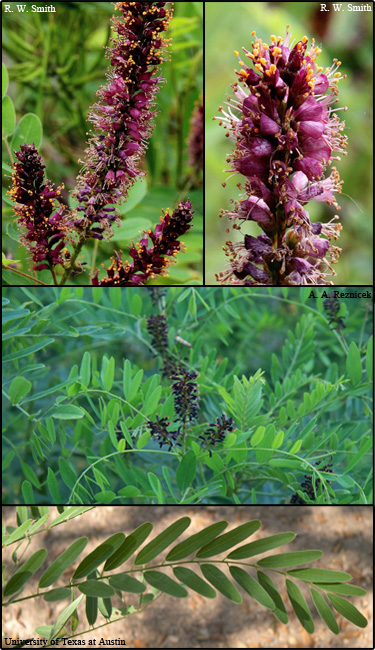False indigo bush (Amorpha fruticosa)
 Synonyms: Amorpha angustifolia, Amorpha bushii, Amorpha croceolanata, Amorpha curtissii, Amorpha dewinkeleri, Amorpha fruticosa L. var. angustifolia, Amorpha fruticosa L. var. croceolanata, Amorpha fruticosa L. var. emarginata, Amorpha fruticosa L. var. oblongifolia, Amorpha fruticosa L. var. occidentalis, Amorpha fruticosa L. var. tennesseensis, Amorpha occidentalis, Amorpha occidentalis var. arizonica, Amorpha occidentalis var. emarginata, Amorpha tennesseensis, Amorpha virgata
Synonyms: Amorpha angustifolia, Amorpha bushii, Amorpha croceolanata, Amorpha curtissii, Amorpha dewinkeleri, Amorpha fruticosa L. var. angustifolia, Amorpha fruticosa L. var. croceolanata, Amorpha fruticosa L. var. emarginata, Amorpha fruticosa L. var. oblongifolia, Amorpha fruticosa L. var. occidentalis, Amorpha fruticosa L. var. tennesseensis, Amorpha occidentalis, Amorpha occidentalis var. arizonica, Amorpha occidentalis var. emarginata, Amorpha tennesseensis, Amorpha virgataCommon Names: Desert false indigo, indigobush
Description: Considered a cultivation escapee exhibiting invasive characteristics. Extensive root system can form nitrogen-fixing nodules.
Habit: Multi-stem suckering shrub growing up to 10 feet tall and nearly as wide. Often grows in dense thickets.
Leaves: Alternate, off-pinnate growing up to 10 inches long. Leaflets typically oblong, entire, mycronate, opposite, 1/2 to 1 1/2 inches long, pubescent to glabrous above and below. Dull green above and light green below.
Stems: Woody, multi-stemmed, and may be covered with fine white pubescence.
Flowers: Borne on tall (up to 6 inches), slender spikes at the ends of twigs, deep purple-blue with long bright orange or yellow anthers, appearing mid-summer, opening from base to tip.
Fruit and seeds: Oblong, curved upward, similar to tiny cucumbers, single seeded, bright green and drying to brown, from 1/4 to 1/2 inch long.
Habitat: Native to North America. Found in roadsides, fencerows, banks, fields, sandy knolls, and river banks.
Reproduction: By seed.
Similar species: Siberian peashrub (Caragana arborescens); Black locust (Robinia pseudoacacia); Rattlebox (Sesbania punicea).
Monitoring and rapid response: Manual and mechanical control may be options on new sites with small plants. Cutting twice annually to reduce seed production. Roundup, Transline and Crossbow applied as a 2% foliar treatment or as a 33% cut and wipe treatment. Credits: The information provided in this factsheet was gathered from the Missouriplants.com, Oklahoma State University Biological Survey, USGS Northern Prairie Wildlife Research Center, Virginia Tech vTree.
Individual species images that appear with a number in a black box are courtesy of the Bugwood.org network (http://www.invasive.org).Individual photo author credits may not be included due to the small display size of the images and subsequent difficulty of reading the provided text. All other images appear courtesy of Google (http://images.google.com).
